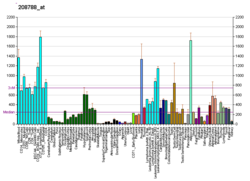| ELOVL5 |
|---|
|
| Identifiers |
|---|
| Aliases | ELOVL5, HELO1, SCA38, dJ483K16.1, ELOVL fatty acid elongase 5 |
|---|
| External IDs | OMIM: 611805; MGI: 1916051; HomoloGene: 41449; GeneCards: ELOVL5; OMA:ELOVL5 - orthologs |
|---|
| Gene location (Human) |
|---|
 | | Chr. | Chromosome 6 (human)[1] |
|---|
| | Band | 6p12.1 | Start | 53,267,398 bp[1] |
|---|
| End | 53,349,179 bp[1] |
|---|
|
| Gene location (Mouse) |
|---|
 | | Chr. | Chromosome 9 (mouse)[2] |
|---|
| | Band | 9|9 E1 | Start | 77,824,646 bp[2] |
|---|
| End | 77,891,801 bp[2] |
|---|
|
| RNA expression pattern |
|---|
| Bgee | | Human | Mouse (ortholog) |
|---|
| Top expressed in | - seminal vesicula
- secondary oocyte
- lactiferous duct
- tibia
- skin of thigh
- trigeminal ganglion
- parietal pleura
- epithelium of nasopharynx
- spinal ganglia
- inferior ganglion of vagus nerve
|
| | Top expressed in | - vestibular membrane of cochlear duct
- Paneth cell
- carotid body
- cumulus cell
- conjunctival fornix
- adrenal gland
- facial motor nucleus
- substantia nigra
- stria vascularis
- anterior horn of spinal cord
|
| | More reference expression data |
|
|---|
| BioGPS | 
 | | More reference expression data |
|
|---|
|
| Gene ontology |
|---|
| Molecular function | - protein binding
- transferase activity
- 3-oxo-arachidoyl-CoA synthase activity
- 3-oxo-cerotoyl-CoA synthase activity
- fatty acid elongase activity
- 3-oxo-lignoceronyl-CoA synthase activity
- very-long-chain 3-ketoacyl-CoA synthase activity
| | Cellular component | - dendritic tree
- dendrite
- integral component of membrane
- cell projection
- endoplasmic reticulum membrane
- neuronal cell body
- membrane
- endoplasmic reticulum
- integral component of endoplasmic reticulum membrane
| | Biological process | - lipid metabolism
- fatty acid biosynthetic process
- linoleic acid metabolic process
- alpha-linolenic acid metabolic process
- fatty acid metabolic process
- unsaturated fatty acid biosynthetic process
- fatty acid elongation, polyunsaturated fatty acid
- very long-chain fatty acid biosynthetic process
- fatty acid elongation, monounsaturated fatty acid
- long-chain fatty-acyl-CoA biosynthetic process
- positive regulation of fatty acid biosynthetic process
- fatty acid elongation, saturated fatty acid
- sphingolipid biosynthetic process
| | Sources:Amigo / QuickGO |
|
| Orthologs |
|---|
| Species | Human | Mouse |
|---|
| Entrez | | |
|---|
| Ensembl | | |
|---|
| UniProt | | |
|---|
| RefSeq (mRNA) | |
|---|
NM_021814
NM_001242828
NM_001242830
NM_001242831
NM_001301856 |
| |
|---|
| RefSeq (protein) | |
|---|
NP_001229757
NP_001229759
NP_001229760
NP_001288785
NP_068586 |
| |
|---|
| Location (UCSC) | Chr 6: 53.27 – 53.35 Mb | Chr 9: 77.82 – 77.89 Mb |
|---|
| PubMed search | [3] | [4] |
|---|
|
| Wikidata |
| View/Edit Human | View/Edit Mouse |
|
















